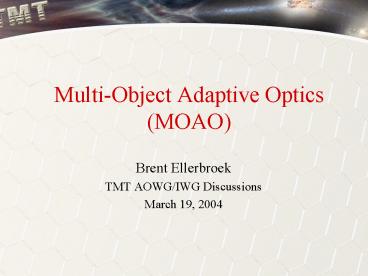MultiObject Adaptive Optics MOAO PowerPoint PPT Presentation
1 / 14
Title: MultiObject Adaptive Optics MOAO
1
Multi-Object Adaptive Optics (MOAO)
- Brent Ellerbroek
- TMT AOWG/IWG Discussions
- March 19, 2004
2
Presentation Outline
- Strawman MOAO Concept
- (Very) preliminary simulation results
- Selected instrument design issues
3
MOAO Strawman Concepts
4
Why Are We Doing This?
- MCAO has two fundamental error sources
- Atmospheric tomography with a finite number of
guidestars - Atmospheric fitting with a finite number of DMs
- MOAO eliminates the atmospheric fitting error
- Surpasses MCAO performance over the same FOV
- Matches MCAO performance over a broader FOV
- MOAO reduces the number of warm optical surfaces
- Significantly reduces emissivity in K, L, and M
bands - Applications for TMT include
- High spatial resolution multi-object IFU
spectroscopy in J, H, and K over a 5 arc minute
field - High spatial resolution spectroscopy in L, M with
high sky coverage
5
Preliminary Simulation Results
- Idealized performance with D30m
- CP turbulence profile
- 5 FOV with 7 NGS
- Order 60 by 60 AO compensation
- No noise, servo lag, or aperture edge effects
- No implementation errors (e.g., DM/WFS
registration) - Somewhat less idealized simulations with D8m
- 5 LGS 4 tip/tilt NGS
- Order 16 by 16 AO compensation
- Include WFS noise and aperture edge effects
6
Performance vs. Guide Star Asterism with D30m
7 guidestars, 0.5 radius
7 guidestars, 2.0 radius
7
Performance vs. Guidestar Asterism with D8m
MOAO
8
Instrument Design Considerations
- Open-loop and/or off-null operation of WFSs and
DMs - Button characteristics
- How large, how many, what do they contain?
- Number of focal planes
- Whats included in the cryostat?
- Filter wheels and ADCs
9
Coping with Nonlinear AO Components
- Real-world AO components have limited linear
dynamic ranges - Each WFS might include its own local DM
- Each DM might include its own local WFS (designed
for large linear dynamic range) - MOAO system could located be behind an adaptive
secondary (or another DM) for low order, large
amplitude correction)
10
Button Taxonomy
11
Two Optical Design Concepts for IFU Buttons
OAP Relay
Single sphere
12
Number of Focal Planes
- Should sources at different wavelengths be
separated spatially, or via dichroics? - Could conceivably use up to 4 focal planes
- Visible/NIR split
- Further split the visible into NGS and LGS
channels - Further split the NIR into science and NGS
channels - Provides more space for all those buttons
- Adds extra (large) optical components and
decreases throughput
13
Sample Focal Plane Configurations
14
Other Options
- Extent of cryostat
- Output fibers only (6-7 warm surfaces)
- One small cryostat per IFU button (3-4 warm
surfaces, much larger buttons) - One large cryostat for IFU buttons (3-4 warm
surfaces, large window) - ADCs and filters
- Large elements for the full field of view?
- Separate elements for each button?

